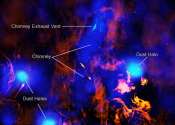Researchers find winds on Uranus and Neptune confined to thin atmosphere layer
(Phys.org) —A team of researchers from the U.S. and Israel has deduced that the winds that blow on Uranus and Neptune are confined to relatively thin atmospheric layers. In their paper published in the journal Nature, the ...








